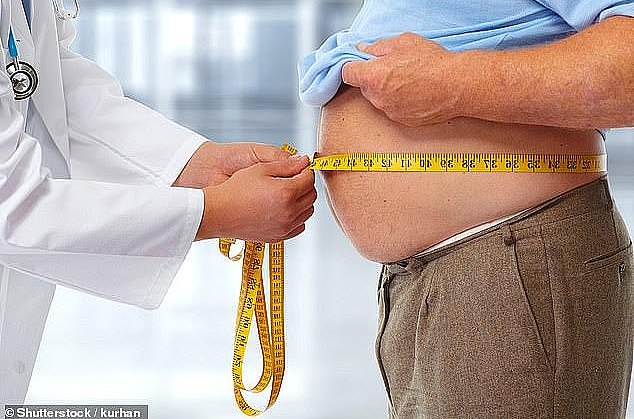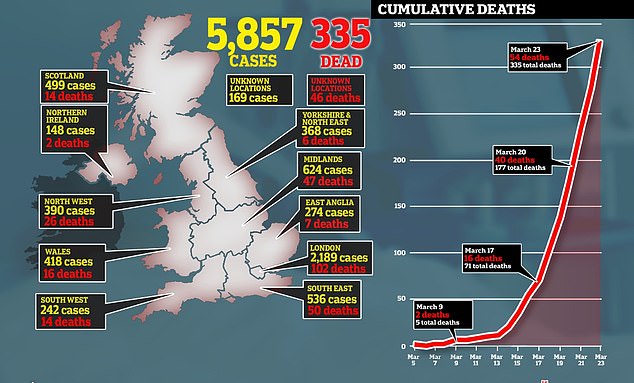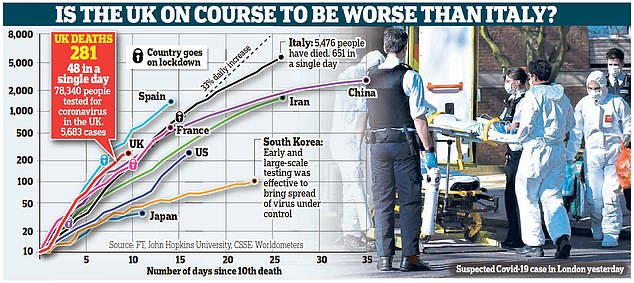Almost two thirds of critically ill coronavirus patients are overweight and 37% are under 60, NHS audit reveals
- Excess weight against chest makes it harder for muscles to draw in deep breath
- Weak immune system allows COVID-19 to spread to lungs and cause pneumonia
- These two factors may explain why two thirds of ICU coronavirus patients obese
- Comes as coronavirus death toll in UK rises to 281 and infections sit at 5,600
- Coronavirus symptoms: what are they and should you see a doctor?
Almost two thirds of patients who fall seriously ill from coronavirus are obese and nearly 40 per cent are under the age of 60, an NHS audit has revealed.
Sixty-three per cent of patients in intensive care in UK hospitals because of the killer virus are overweight, obese or morbidly obese.
While the average age of people suffering the most serious symptoms of coronavirus is 64, 37 per cent are under the age of 60.
The Intensive Care National Audit and Research Centre analysed all admissions to critical care units in the UK up until midnight last Thursday.
At that time, there were 194 coronavirus patients in ICU. That number is thought to have soared in the last four days.
The document provided the first in-depth look at patients who have needed round-the-clock care and boosted medics’ understanding of the virus that has crippled society.
Its finding that obese people are at risk of serious complications from COVID-19 will be concerning for health bosses, as two thirds of adults in the country fall into the category.

Almost two thirds of patients who fall seriously ill from coronavirus are obese, as medics warn being overweight raises the risk of dying from the disease


People are pictured enjoying fish and chips on a bench in Skegness as crowds flocked to the resort despite warning about COVID-19
And more than a third of critically ill patients being under 60 shows it is not only the very elderly who are at risk.
The report also found that most coronavirus patients in intensive care were male, 71 per cent of all cases, and only 18 patients (9 per cent) had ‘severe co-morbidities’, such as underlying heart conditions or lung disease; while two patients had been pregnant within the last six weeks.
Studies have shown obese people are more likely to suffer serious complications or die from infections, such as the flu.
Doctors say the immune systems of fat people are constantly ramped up as they try to protect and repair the damage inflammation causes to cells.
Using all its energy fending off inflammation means the body’s defence system has few resources left to defend against a new infection like COVID-19.
Obese people also tend to eat a diet with very little fiber and antioxidants – which keep the immune system healthy – such as fruit and vegetables.
Excess weight makes it more difficult for the diaphragm and lungs to expand and inhale oxygen. Starved of oxygen, organs will begin to fail.
These factors may explain why obese people’s lungs tend to deteriorate faster when the new coronavirus strikes, compared to a healthy person.
COVID-19, which has infected more than 300,000 people worldwide, kills by spreading deep into the lungs and causing complications such as pneumonia.
There are several other factors that may increase an obese person’s chance of falling seriously ill with coronavirus, including a lack of exercise.


People packed Bournemouth esplanade this morning (Sunday). Paddle boarders and swimmers braved the cold temperatures despite fears over the global coronavirus outbreak
Studies have shown that physical activity increases the numbers of certain immune cells that help to bolster immune activity.
Clogged up arteries also make it hard for blood carrying immune cells to circulate and travel to various parts of the body to defeat infections.
It comes after thousands of Britons flouted social distancing restrictions and flocked to beeches, parks and town centres on Mother’s Day.
Prime Minister Boris Johnson has warned people who weren’t following Government advice that they have just 24 hours to take the measure seriously.
He threatened to exert stricter controls to help fight the outbreak and has not ruled out police officers roaming the streets and arresting those who fall foul of the rules.

Oh I do like to be beside the seaside! Visitors continued to flock to seaside resorts today including this one in West Bay, Dorset

Pen y Pass near Llanberis in Gwynedd on Sunday morning as visitors ignore requests to stay away on Snowdonia today
With 281 people now known to have died from the virus in the UK, the PM used his daily press conference yesterday to warn there was ‘no doubt’ he would act to close open spaces and limit all movement outside homes if people continued to act foolishly, but stopped short of immediate action.
He later added: ‘I don’t think you need to use your imagination very much to see where we might have to go, and we will think about this very very actively in the next 24 hours.’
Mr Johnson told the nation it was only ‘two or three’ weeks behind Italy where the death toll has already risen above 4,000 making it the worst outbreak anywhere in the world.
There were 47 new cases identified in the UK on Sunday alone, with Britain’s youngest victim to date dying at University Hospital, Coventry.
Mr Johnson said that unless the UK could control the spread of the virus through social distancing, the NHS would be ‘overwhelmed’ in the same way that the Italian healthcare system had been.
The surge in cases of the virus comes on the day Mr Johnson urged families to stay apart and instead celebrate Mother’s Day via Skype and other remote communications.
In a tough message to the public from Downing Street this afternoon, Mr Johnson said that even though he understood the physical and mental health benefits of open spaces, he would take drastic steps to protect health.
Ministers are considering following other countries such as Italy and Spain that have banned people from leaving their homes unless they need to go to work or to buy essential food and supplies.
Spanish police arrested 157 people for disobeying the rules in just the first five days, while Italian authorities have the power to fine anyone caught entering or leaving the area of the country worst hit by the virus. Germany has banned gatherings of more than two people outside people’s homes.
Mr Johnson said: ‘I don’t think you need to use your imagination very much to see where we might have to go, and we will think about this very, very actively in the next 24 hours.’
Communities Secretary Robert Jenrick said people need to realise it ‘isn’t a game’.
London Mayor Sadiq Khan said the police and Army may soon be required to enforce social distancing, as he warned that unless people stay at home ‘more people will die’.
